What Makes Suzhou Museum a Must-Visit Destination for Culture Lovers?
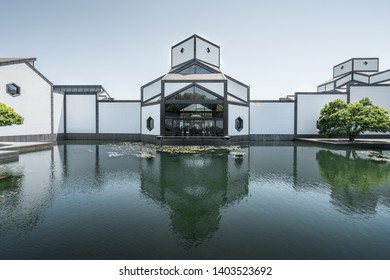
An Essential Guide to Visiting Suzhou Museum
Nestled gracefully on the western side of the enchanting Humble Administrator’s Garden, the Suzhou Museum is more than just a repository of artifacts; it is an architectural masterpiece designed by the renowned I.M. Pei. This stunning blend of modern design and traditional Suzhou aesthetics invites travelers to explore a treasure trove of cultural heritage, showcasing the rich tapestry of Suzhou’s history, art, and craftsmanship.
In this guide, we will take you through essential information to enhance your visit, including tips on navigating the museum’s exhibits, highlights you won’t want to miss, and details about nearby attractions and dining options. Whether you’re an art enthusiast, a history buff, or simply seeking a serene cultural experience, the Suzhou Museum promises to captivate your imagination and enrich your understanding of this picturesque city. Prepare to immerse yourself in a world where history and artistry intersect, creating a truly unforgettable journey.
In This Guide
- An Essential Guide to Visiting Suzhou Museum
- The Rich History and Legends of Suzhou Museum
- Main Highlights: What You Absolutely Can’t Miss
- Planning Your Visit: A Practical Guide
- Tickets: Prices, Booking, and Tips
- How to Get There: A Complete Transportation Guide
- Local Cuisine and Accommodation Nearby
- Frequently Asked Questions
- Final Thoughts on Your Trip
The Rich History and Legends of Suzhou Museum
A Journey Through Time: The Origins of Suzhou Museum
Nestled in the picturesque city of Suzhou, the Suzhou Museum is not just a repository of artifacts; it’s a testament to the rich cultural heritage of the region. Established in 1960, this museum was born out of a desire to preserve and showcase the historical treasures of Suzhou, a city renowned for its classical gardens and silk production. Originally housed in a modest facility, the museum’s ambitions grew alongside its collection, prompting a transformation that would lead to its current architectural marvel.
Architectural Masterpiece by I.M. Pei
In 2006, the museum unveiled a stunning new building designed by the internationally acclaimed architect I.M. Pei, a Suzhou native. This modern structure harmonizes with the traditional aesthetics of Chinese architecture, incorporating elements that reflect the essence of Suzhou’s famed gardens. The museum’s design features elegant courtyards, serene water features, and a meticulous balance of light and shadow, creating a tranquil ambiance for visitors as they explore the rich narratives contained within its walls.
Key Historical Milestones
Throughout its history, the Suzhou Museum has undergone several significant developments:
- 1960: The museum was established to protect and exhibit local cultural relics.
- 1995: The museum received national recognition, further elevating its status as a cultural hub.
- 2006: The opening of the new museum building marked a new era, with expanded exhibition space and modern facilities that cater to a global audience.
These milestones reflect the museum’s continuous evolution, striving to make Suzhou’s heritage accessible and relevant to an expanding world of visitors.
Legends and Cultural Significance
The history of Suzhou is steeped in legend, and the museum serves as a vessel for these captivating tales. Among the most famous is the story of the “Humble Administrator’s Garden,” located just beside the museum. It is said that the garden was created by a scholar who longed for a life of peace and simplicity after years of failed examinations. The garden embodies his desire for tranquility, and visitors can feel the echoes of his dreams as they stroll through its winding paths, a sentiment reflected in the museum’s tranquil setting.
Another legend associated with Suzhou revolves around the city’s legendary silk production. The tale speaks of a princess who discovered the secret of sericulture—raising silkworms for silk production—while wandering through the lush landscapes of Suzhou. This discovery not only transformed the city into a silk capital but also laid the foundation for the cultural exchange that would follow. The museum houses exquisite silk artifacts, allowing visitors to appreciate the craftsmanship that has been perfected over centuries.
A Cultural Beacon for the Future
Today, the Suzhou Museum stands as a cultural beacon, bridging the past with the present. With a collection that spans thousands of years, it offers insights into the art, history, and natural beauty of Suzhou. The museum’s commitment to education and community engagement ensures that its rich history and legends will continue to inspire generations to come.
As you wander through its halls, you’ll find not just exhibits but stories—of scholars, artisans, and dreamers—woven into the very fabric of Suzhou’s identity. Visitors from around the world leave with a deeper understanding of the city’s profound heritage, making the Suzhou Museum a must-visit for anyone eager to explore the rich tapestry of Chinese culture.

Suzhou Museum.
Main Highlights: What You Absolutely Can’t Miss
The Architectural Marvel
As you approach the Suzhou Museum, the first thing that will capture your attention is its stunning architecture. Designed by the renowned I.M. Pei, the museum seamlessly blends traditional Suzhou aesthetics with modern design elements. The iconic white walls, sloping roofs, and reflective ponds create a serene atmosphere, inviting you to explore the treasures within. Tip: Arrive early in the morning to enjoy the museum’s tranquil ambiance before it gets crowded.
The Ancient Artifacts Gallery
Step inside to marvel at the Ancient Artifacts Gallery, where history comes alive through a fascinating collection of pottery, jade, and bronze artifacts. Each piece tells a story of Suzhou’s rich cultural heritage, dating back thousands of years. Don’t miss the exquisite jade pieces that showcase the intricate artistry of ancient craftsmen. Tip: Take your time to read the informative plaques next to each exhibit for deeper insight into the history and significance of these artifacts.
The Garden of the Heart
Adjacent to the museum is a beautifully landscaped garden known as the Garden of the Heart (心园). This tranquil space provides a perfect escape from the bustling city and reflects the classic Suzhou garden style, complete with rockeries, water features, and lush greenery. It’s an ideal spot for photography or simply enjoying a moment of peace. Tip: Bring a snack or a book to enjoy a leisurely break in the garden, allowing yourself to soak in the beauty around you.
The Calligraphy and Painting Exhibition
Art enthusiasts will find the Calligraphy and Painting Exhibition a highlight of their visit. This section showcases works from renowned Chinese calligraphers and painters, both contemporary and historical. The fluid brushstrokes and vivid colors reflect the depth of Chinese artistic tradition. Tip: Join a guided tour if available; the insights from knowledgeable guides can greatly enhance your understanding and appreciation of the art on display.
The Silk Road Treasures
Dive into the fascinating history of the Silk Road at the museum’s dedicated exhibit. Here, you’ll discover artifacts that illustrate Suzhou’s historical role as a key trading hub, including beautiful silk pieces and intricate textiles. The exhibit captures the essence of cultural exchange that flourished along the Silk Road. Tip: Make sure to check out the interactive displays that allow you to learn about the journey of silk from production to trade.
The Souvenir Shop
Before you leave, don’t forget to visit the museum’s souvenir shop, a treasure trove of unique items ranging from art prints to handmade crafts. It’s the perfect place to pick up a special memento of your visit or to find a thoughtful gift for friends and family. Tip: Look for items that are locally made, ensuring that your souvenirs support local artisans.
The Convenient Location
The Suzhou Museum is conveniently located next to the Humble Administrator’s Garden, one of the city’s most famous attractions. After your museum visit, consider exploring the garden, which is a UNESCO World Heritage Site, to experience another facet of Suzhou’s cultural heritage. Tip: Plan your visit to the museum in the morning and the garden in the afternoon to maximize your experience of both remarkable sites.
Each of these highlights offers a unique glimpse into the rich tapestry of Suzhou’s history and culture, making the museum an unmissable destination on your travels.
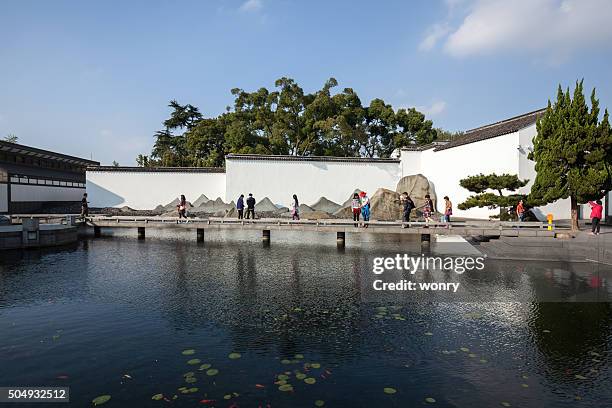
Suzhou Museum.
Planning Your Visit: A Practical Guide
Making the Most of Your Visit to Suzhou Museum
Visiting Suzhou Museum is a wonderful opportunity to delve into the rich history and culture of Suzhou. To ensure you make the most of your visit, here’s a practical guide covering everything from the best time to go to insider tips that will enhance your experience.
Best Time to Visit
The Suzhou Museum is open year-round, but the best time to visit is during the spring (March to May) and autumn (September to November) months. During these periods, the weather is mild, making it comfortable for walking and exploring both the museum and its beautiful surroundings, including the nearby Humble Administrator’s Garden. Avoid weekends and public holidays if possible, as the museum can get crowded.
Recommended Itinerary
Duration: Plan to spend about 1-2 hours at the museum. Here’s a suggested itinerary:
- Arrival: Allow time to explore the museum’s stunning architecture, designed by the renowned I.M. Pei.
- Exhibits: Start with the permanent exhibits, showcasing traditional Chinese art, ceramics, and calligraphy.
- Temporary Exhibits: Check out any temporary exhibits that may be on display during your visit. These often feature rotating themes and collections.
- Gift Shop: Before you leave, browse the museum shop for unique souvenirs that reflect Suzhou’s cultural heritage.
Photography Tips
- Lighting: The museum’s interior is well-lit, but be mindful of glare from glass cases. Early morning or late afternoon light can provide beautiful, soft illumination.
- No Flash: Remember that flash photography may not be allowed in certain areas, especially near sensitive artifacts. Always check for signs or ask staff if unsure.
- Architectural Shots: The exterior of the museum is just as stunning as the interior. Capture the harmonious blend of traditional and modern design, especially just after sunrise or before sunset for dramatic effects.
What to Wear
- Comfortable Shoes: Expect to do a fair amount of walking, so wear comfortable shoes that can handle the museum’s floors and the surrounding gardens.
- Layered Clothing: Since indoor temperatures can vary, wearing layers will help you stay comfortable throughout your visit.
- Sun Protection: If you plan to walk around the nearby gardens after your museum visit, consider wearing a hat and sunscreen, especially during the summer.
Insider Tips
-
Guided Tours: Consider joining a guided tour for deeper insights into the artworks and artifacts. Many tours are available in English, enabling you to appreciate the context behind the exhibits.
-
Combine with Nearby Attractions: After the museum, explore the Humble Administrator’s Garden, just a few steps away. This UNESCO World Heritage site is an excellent way to experience Suzhou’s classical garden design.
-
Free Admission: Take advantage of the free admission policy. While you don’t need to purchase a ticket, it’s wise to arrive early to secure your spot, especially during peak tourist seasons.
-
Enjoy Local Cuisine: After your visit, treat yourself to some local Suzhou cuisine at nearby restaurants. Try the famous Suzhou-style mooncakes or the delectable sweet and sour spare ribs.
-
Plan for Souvenirs: The museum’s gift shop offers unique and locally made souvenirs that can serve as wonderful mementos of your trip. Don’t forget to check it out before you leave!
With this guide in hand, you’re ready to enjoy your visit to Suzhou Museum to the fullest. Embrace the culture, capture the beauty, and immerse yourself in the history of one of China’s most enchanting cities!
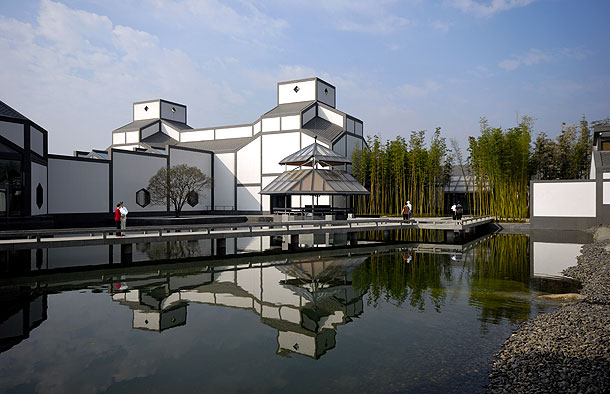
Suzhou Museum.
Tickets: Prices, Booking, and Tips
Visiting the Suzhou Museum is a delightful experience, offering a glimpse into the rich cultural heritage of this ancient city. Below is the essential information you need regarding ticket prices, booking options, and some handy tips to ensure a smooth visit.
| Ticket Type | Price (CNY) | Includes |
|---|---|---|
| Adult | Free | Access to all permanent exhibits |
| Students | Free | Access to all permanent exhibits (ID required) |
| Seniors (60+) | Free | Access to all permanent exhibits (ID required) |
| Special Exhibits | 20 – 50 | Access to temporary exhibitions (price varies) |
Booking Information
-
Entry: Admission to the Suzhou Museum is free for all visitors, but it is advisable to book your visit in advance, especially during peak tourist seasons. This ensures you can secure entry and avoid long wait times.
-
Online Reservations: You can book your tickets through the official Suzhou Museum website or third-party travel platforms. Simply select your desired date and time for entry.
-
On-Site Tickets: While you can buy tickets on-site for special exhibitions, these may sell out quickly. Therefore, securing your spot online is recommended.
Tips for a Great Visit
-
Plan Your Visit: Allocate about 1-2 hours to explore the museum thoroughly. Given its location next to the Humble Administrator’s Garden, consider visiting both sites in one day.
-
Visit During Weekdays: To avoid crowds, try to visit during weekdays, as weekends can become quite busy.
-
Check for Special Exhibitions: Keep an eye on the museum’s calendar for any special exhibitions or events that might be taking place during your visit.
By keeping these details in mind, you can enjoy a seamless experience at the Suzhou Museum, immersing yourself in the art and culture that this enchanting city has to offer. Happy traveling!
How to Get There: A Complete Transportation Guide
Planning Your Visit to Suzhou Museum
Located in the picturesque city of Suzhou, the Suzhou Museum is an architectural gem that offers a glimpse into the region’s rich cultural heritage. Here’s how to easily reach the museum and navigate the surrounding scenic area.
From the Nearest Major City: Shanghai
By Train
Traveling from Shanghai to Suzhou is convenient and efficient, thanks to China’s extensive high-speed rail network.
- Departure Station: Shanghai Hongqiao Railway Station
- Arrival Station: Suzhou Railway Station
- Duration: Approximately 25-30 minutes
- Cost: Tickets range from ¥40 to ¥80 (around $6 to $12) depending on the class of service.
Trains run frequently—typically every 15 to 30 minutes—so you can choose a time that best fits your schedule.
By Bus
For a more budget-friendly option, consider taking a long-distance bus.
- Departure Points: Various bus stations in Shanghai, such as Shanghai South Long-Distance Bus Station.
- Duration: Approximately 1.5 to 2 hours.
- Cost: Tickets usually cost around ¥30 (approximately $4.50).
Buses can be less frequent than trains, so check the schedule ahead of time.
By Car
If you prefer driving or wish to explore at your own pace, renting a car is a viable option.
- Distance: About 100 kilometers (62 miles) via G2 highway.
- Duration: Approximately 1.5 to 2 hours, depending on traffic.
- Tolls: Expect to pay around ¥50 (about $7.50) in tolls.
Getting to Suzhou Museum from Suzhou Railway Station
Once you arrive at Suzhou Railway Station, reaching the museum is straightforward:
By Taxi
- Duration: Approximately 20 minutes.
- Cost: Around ¥20-30 (about $3-5).
By Public Bus
Several bus lines connect the railway station to the museum:
- Bus Line: Take Bus No. 36 or 45.
- Duration: Approximately 30 minutes.
- Cost: A single ride costs ¥2 (about $0.30).
By Bicycle
For those who enjoy cycling, consider renting a bike. Suzhou has a well-developed bike-sharing system.
- Duration: Approximately 30-40 minutes.
- Cost: Bike rentals typically cost around ¥1-3 per hour (about $0.15-$0.50).
Getting Around the Scenic Area
The Suzhou Museum is situated near several other attractions, including the Humble Administrator’s Garden and Pingjiang Road. Here’s how to navigate the scenic area:
Walking
- Accessibility: The museum is within walking distance of many nearby attractions, making it easy to explore on foot.
- Recommended Route: Start at the museum, walk to the Humble Administrator’s Garden (just a 5-minute stroll), and then head to Pingjiang Road, which is about a 15-minute walk away.
Public Transportation
If you prefer not to walk, Suzhou’s public transportation system is efficient:
- Buses: Various bus lines service the area.
- Cost: A single ride costs around ¥2 (about $0.30).
Taxis
Taxis are readily available throughout the city.
- Cost: Short rides usually cost between ¥15-30 (around $2.50-$5).
- Convenience: Taxis can be a good option if you’re visiting multiple sites in a day.
Conclusion
Whether you’re arriving from the vibrant city of Shanghai or exploring Suzhou itself, reaching the Suzhou Museum and its scenic surroundings is both convenient and enjoyable. With various transportation options at your disposal, you can easily immerse yourself in the culture and beauty of this enchanting city.
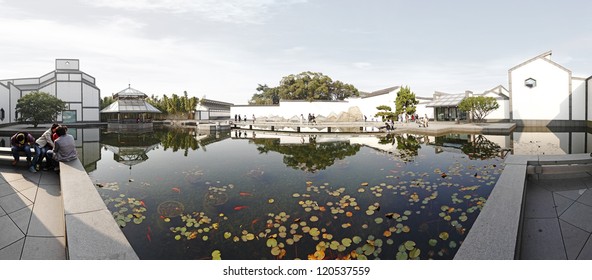
Suzhou Museum.
Local Cuisine and Accommodation Nearby
Just a stone’s throw from the Suzhou Museum, you can indulge in the delightful local cuisine and find a range of accommodations to suit any traveler’s needs.
Culinary Delights
-
Suzhou-style Noodles (苏州面)
Known for their silky texture, these hand-pulled noodles are often served with a rich broth and topped with fresh vegetables and marinated meats. Savory and satisfying, they are a must-try for noodle enthusiasts. -
Sweet and Sour Mandarin Fish (糖醋桂花鱼)
This iconic dish features a whole fish, expertly fried and then drenched in a tangy sweet and sour sauce made from vinegar and sugar. Often garnished with a sprinkle of edible flowers, it’s as visually appealing as it is delicious. -
Squirrel Fish (松鼠鳜鱼)
Another signature dish from Suzhou, squirrel fish is a deep-fried and beautifully presented fish, garnished with sweet and sour sauce. The presentation mimics a squirrel’s tail, making it as delightful to look at as it is to eat. -
Steamed Buns (小笼包)
These delicate, soup-filled buns are a local favorite. Made from thin dough and typically filled with pork or crab, they burst with flavor in every bite. Pair them with a bit of vinegar and ginger for an authentic experience.
Accommodation Options
-
Luxury: Pan Pacific Suzhou
Located near the picturesque gardens of Suzhou, Pan Pacific offers a blend of modern luxury and traditional elegance. With stunning views, an on-site spa, and exquisite dining options, it’s perfect for travelers seeking comfort and class. -
Boutique: The Garden Hotel
Nestled in a tranquil area, this boutique hotel boasts a charming design inspired by Suzhou’s classical gardens. Each room is uniquely decorated, and guests can enjoy personalized service along with delicious breakfast options featuring local flavors. -
Budget: Jinjiang Inn Suzhou Pingjiang Road
Ideal for budget-conscious travelers, this hotel offers clean and comfortable accommodations without breaking the bank. Located within walking distance from the museum, it provides easy access to local attractions and eateries. -
Hostel: Suzhou International Youth Hostel
For those looking to meet fellow travelers, this hostel provides a vibrant atmosphere with dormitory-style accommodations. With a communal kitchen and lounge area, it’s a great spot to relax and share travel stories.
Whether you’re savoring the local dishes or enjoying a restful night in one of the nearby accommodations, your visit to Suzhou Museum promises to be a rich cultural experience filled with culinary and hospitality delights.
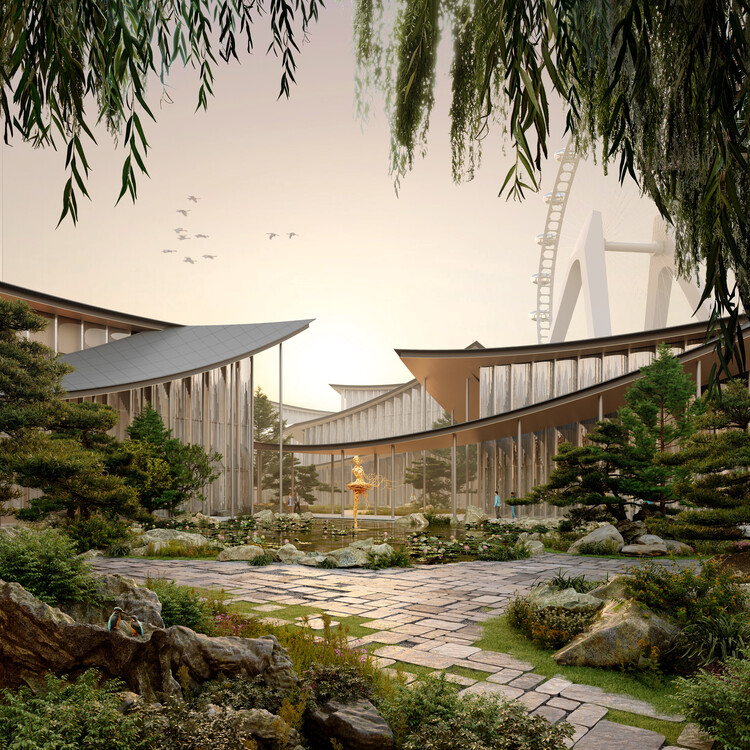
Suzhou Museum.
Frequently Asked Questions
Here are some common questions travelers might have about visiting the Suzhou Museum, along with clear and informative answers:
-
Is Suzhou Museum suitable for children and the elderly?
Yes, Suzhou Museum is suitable for visitors of all ages. The museum features various engaging exhibits that can capture children’s interest, while its accessible layout and seating areas make it comfortable for elderly visitors. -
Are there English signs and information available?
Yes, the museum provides English signage and information throughout the exhibits, making it easy for international visitors to navigate and understand the displays. -
How much time should I plan to spend at the museum?
Most visitors typically spend about 1 to 2 hours exploring the museum. This allows ample time to enjoy the exhibits, take photographs, and visit the souvenir shop. -
What are the opening hours of Suzhou Museum?
The museum is open Thursday through Tuesday from 9:00 AM to 5:00 PM and is closed on Wednesdays. Make sure to check for any updates on holiday hours before your visit. -
Is there an entrance fee?
Admission to Suzhou Museum is free, making it an excellent option for budget-conscious travelers. However, it’s advisable to check for any special exhibitions that may have an entry fee. -
Is photography allowed inside the museum?
Yes, photography is generally allowed in most areas of the museum. However, be sure to respect any signs indicating restrictions in specific sections or during special exhibitions. -
Are there facilities for refreshments on-site?
While the museum itself does not have a full café, there is a souvenir shop that offers some light snacks and drinks. For a more substantial meal, consider visiting nearby restaurants after your visit. -
How do I get to Suzhou Museum from the city center?
Suzhou Museum is conveniently located in the Pingjiang District, near the Humble Administrator’s Garden. You can reach it by taxi, public bus, or even on foot if you’re staying nearby. The museum’s central location makes it easy to incorporate into a day of exploring Suzhou.
Final Thoughts on Your Trip
Visiting the Suzhou Museum is more than just a trip to an art space; it’s an immersion into the rich tapestry of Chinese history and culture. Nestled near the famous Humble Administrator’s Garden, the museum is an architectural marvel that harmoniously blends modern design with traditional aesthetics. As you wander through its thoughtfully curated galleries, you’ll encounter exquisite collections of ancient artifacts, intricate silk artworks, and stunning pottery that speak to the artistry and craftsmanship of bygone eras.
Whether you’re a history buff, an art lover, or simply seeking a moment of tranquility amidst bustling Suzhou, the museum offers a serene environment that invites reflection and appreciation. Don’t forget to stop by the souvenir shop to take home a piece of Suzhou’s charm.
As you conclude your visit, remember that each exhibition tells a story, and every artwork is a window into the past. Embrace the inspiration this experience brings and carry it with you as you continue to explore the beauty and depth of Chinese culture. Your journey through the Suzhou Museum is just the beginning of a greater adventure in this enchanting city.